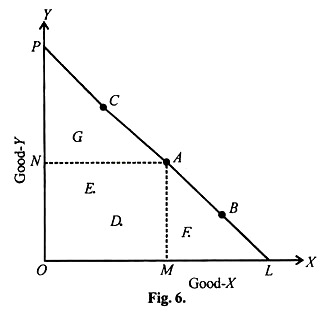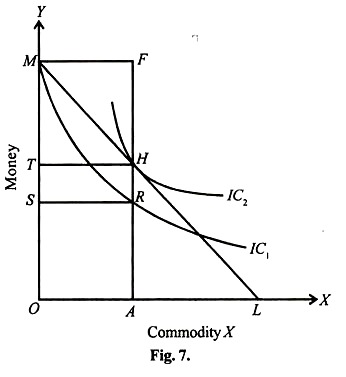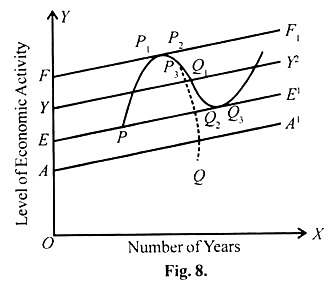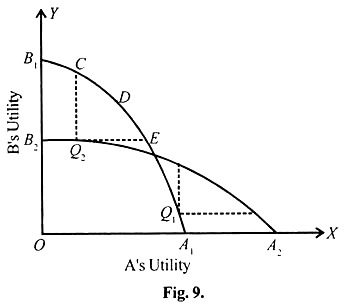The following points highlight the top eleven economic ideas of Sir John Hicks. the economic ideas are: 1. Definition of Economics 2. Consumer Equilibrium 3. Revision of Demand Theory 4. Consumer’s Surplus 5. Population 6. Right Man on the Right Job 7. General Equilibrium 8. Economic Dynamics 9. Stationary State 10. Theory of Trade Cycle 11. Welfare Economics.
Economic Idea # 1. Definition of Economics:
To Hicks, economics is essentially a branch of human science. He has defined economics as “the science which deals with business affairs”. He considers it to be superior to other human science in the sense that it has been able to apply scientific methods to the study of human conduct in a better way.
His only suggestion is that since economics deals with facts, efforts must be made to arrange these facts rightly, otherwise they will be of no use.
Economic Idea # 2. Consumer Equilibrium:
Hicks has made notable contribution to the study of consumer equilibrium by making use of indifference curve approach. The ordinalist approach of Hicks is considered superior to the Marshallian utility approach or cardinalist approach. Indifference curve technique assumes what is called “ordinal measurement of utility”.
ADVERTISEMENTS:
Another distinct improvement made by Hicks is unlike Marshall, he explains consumer’s behaviour without the assumption of constant marginal utility of money. Further through his indifference curve technique, Hicks distinguished between income and substitution effects.
The distinction between income effect and substitution effect of a price change enables us to gain better understanding of the effect of a price change on the demand for a good. The amount demanded of a good generally rises as a result of the fall in its price due to two reasons.
Firstly, because real income rises as a result of the fall in price (income effect) and
ADVERTISEMENTS:
Secondly, because the good whose price falls becomes relatively cheaper than others and therefore the consumer substitutes it for other (substitution effect).
Economic Idea # 3. Revision of Demand Theory:
Hicks in his “Revision of Demand Theory”, has taken note of some of the recent developments in demand theory and incorporated them.
He used ordinal utility theory but he rejected indifference curve technique for two reasons:
(1) Indifference curve technique is useful only if we have to select between two goods. If there are more than two goods, then we have to rely on mathematics.
ADVERTISEMENTS:
(2) Second disadvantage of indifference curve is that it is based on the assumption of continuity.
He therefore dispenses indifference curve along with this assumption of continuity.
Assumptions:
1. It is based on preference hypothesis. It states that the consumer selects the one which he prefers the most from among the alternatives open to him.
2. More of a commodity is always preferred to less of it.
3. It is based on weak ordering that is items cannot be arranged one after another. It can only be grouped. Those groups can be strongly ordered but within the group ordering is not possible.
4. Weak ordering depends on two conditions:
(a) Two term consistency condition and
(b) Transitivity condition
ADVERTISEMENTS:
5. There are two commodities x and m. Price of x changed and that of m remain constant. M is a composite commodity.
The difference between revealed preference theory and revision of demand theory is shown in fig. 6 :
According to revealed preference theory, which is based on strong ordering, chosen point is preferred to all points within and on the triangle. Revision of demand theory is based on weak ordering in which chosen point A’ is preferred to all points with in the triangle but may be indifferent to other points on the boundary line.
Economic Idea # 4. Consumer’s Surplus:
ADVERTISEMENTS:
Consumer’s surplus, as developed by Marshall is based on the assumption that the marginal utility of money is constant. This assumption is considered wrong. If we relax the assumption, the size of the consumer’s surplus is smaller than the Marshallian theory. Indifference curve analysis has been used by Hicks to demonstrate this.
Indifference curves technique does not make the assumption of cardinal measurability of utility, nor does it assume that marginal utility of money remains constant.
How consumer’s surplus is measured with the aid of indifference curves is illustrated in the following figure (Fig. 7):
ADVERTISEMENTS:
Suppose a consumer has OM amount of money which he can spend on good A and other goods. The indifference curve IC1 touches this point M indicating that all combinations of money and commodity X give same satisfaction to the consumer. For example at point R on IC1 OA amount of commodity and OS amount of money will give the same satisfaction.
In other words, it means that the consumer is willing to pay MS amount of money for OA amount of X. He is prepared to give up FR (=MS) for OA amount of good X.
Suppose if the price line is ML, it is tangent to the indifference curve IC2 at point H. In this equilibrium point, the consumer is having OA amount of good X and OT amount of money. Thus at the given price of X, the consumer has given up MT amount of money for acquiring OA amount of X. But he was prepared to forego MS (or FR) amount of money for OA. Therefore the consumer pays TS (or) HR less amount of money. Thus TS (or) HR is the consumer’s surplus which the consumer derives from purchasing OA amount of good X.
In this way, Hicks explained the consumer’s surplus with his indifference curve technique without assuming cardinal measurability of utility and without assuming constancy of the marginal utility of money.
Economic Idea # 5. Population:
Hicks is not worried over the problem of over population in a country. He feels that “the over population of particular areas can easily be remedied by industrialisation”. In this connection he has cited the example of Great Britain.
He is of the view that for meeting the needs of food, clothing etc. of an increasing population, the production should also be simultaneously increased. If agricultural production cannot be increased owing to the shortage of land, industrial production must be increased.
Economic Idea # 6. Right Man on the Right Job:
ADVERTISEMENTS:
According to Hicks, the economic organisation of a community must be done in such a way that the working force is utilised in an efficient manner. He means to say that persons with particular qualifications and talents should be employed on those jobs for which they are best suited or where their talent can be best utilised.
This implies that the distribution of labour force among the various occupations should be done according to the requirements of the community and should not be left to the will of the producers. Although the method of incentives is better than the method of compulsion, the latter can prove to be more fruitful if it is followed by an adequate system of selection.
Economic Idea # 7. General Equilibrium:
Hicks’ analysis of general equilibrium is chiefly concerned with the problem of general equilibrium under conditions of perfect competition. He has only studied the problem from the point of view of an individual firm. He is of the view that this concept of equilibrium has a wider application than that of the general equilibrium of exchange, since it relates to production.
This analysis can be made to apply not only to the problems raised by the classical economists, but also to other long term problems, particularly in the fields of distribution and international trade. He has however warned that the universal application of this hypothesis should not be tried, since it may lead to the same errors as has been committed by earlier economists.
Hicks has been quite frank in stating the weaknesses of his system.
According to him, this system suffers from three defects:
ADVERTISEMENTS:
(a) It does not take into account the monopolistic conditions and imperfect competition
(b) It detracts from the economic activity of the state
(c) It detracts from capital, interest, saving, investment and speculation.
Economic Idea # 8. Economic Dynamics:
According to Hicks, Economic statics includes the study of those elements of economic theory, whose dating is not required. On the other hand economic dynamics treats of those parts where every quantity must be dated.
Further in economic statics, the economist is concerned with knowing that the producer, after employing certain quantities of factors of production, has been able to produce a certain amount of product and not with such questions as to when those factors were employed and when the commodities were produced.
In economic dynamics these questions are the most significant and the economists after knowing the “when” of the problem try to create a relationship between the variation in time, the quantity of factors and the goods produced and also the way these changes in dates have affected the relationship between factors and products.
Economic Idea # 9. Stationary State:
ADVERTISEMENTS:
According to Hicks the stationary state is a special case of dynamic system. In such a state, tastes, techniques and resources remain stationary over a given period of time. Again in such a state, the problem of distinguishing between actual price and expected price, income and commodities, money and real rate of interest, is not felt.
Hicks feels that, it is the treatment of the stationary state that has hampered the development of a proper theory of interest. In such a state, equilibrium is not only established when demand and supplies are equal, at the current prices, but also when the prices are constant over a period of time. Hence he concludes that equilibrium over a period of time can only be possible in a much longer period and therefore, it cannot be achieved in real life.
It may be ideal from the theoretical point of view but from the practical point of view, it is an impossibility. Therefore Hicks says that the economists should be interested in temporary equilibrium.
Economic Idea # 10. Theory of Trade Cycle:
Hicks contribution to the “Theory of Trade Cycle” has been regarded as one of the major contributions to trade cycle theories. It is apt to quote, “A beautiful theory of the cycle is here built up with an admirable economy of means… undoubtedly a tour de force”.
Hicks has developed the theory by making use of the accelerator—multiplier interaction principle and autonomous and induced investment. Dussenberry describes it as an, “ingenious piece of work” and “the first coherent theory of the cycle to appear in some years”.
The multiplier is related to the autonomous investment of the government. The acceleration is based on induced investment. We can show the influence of the two types of investment on the level of income and cyclical fluctuations with the help of a diagram.
In Fig.8, the horizontal axis represents the number of years and the vertical axis, the level of economic activity. Line AA1 represents the progress over the years. It slants upward at a uniform rate to indicate that autonomous investment grows over time at a constant rate.
Line EE, represents the income or output corresponding to the autonomous investment line AA1 but EE1 is at a higher level because it represents the combined influence of multiplier and acceleration effects as a result of autonomous investment (AA1). In fact the distance between AA1 and EE1 will depend upon the combined influence of the multiplier and acceleration effects. Finally, line EE, represents the level of full employment income—”full employment ceiling”.
Suppose the economy is at point P and a certain invention is introduced. As a result, there is a burst of autonomous investment. But the induced investment will push output, employment etc. upward along the path marked PP1 away from the EE1 line. The upward trend touches full employment ceiling at P1 and it cannot raise further. When the path has touched the ceiling, it must move in a downward direction after some time.
This downward swing, according to Hicks is inevitable. The initial burst of autonomous investment is short-lived and after a stage it will fall to the usual level. But the induced investment which was the result of the initial autonomous investment and the initial increase in output would continue and push ahead on path PP1. But the induced investment is not sufficient to support a growth of output along the path EE1 It is sufficient to support an output which expands along the equilibrium path EE1. Therefore output will return from EE1 back to EE1.
The downward swing can be gradual along the path P2 Q1Q2 or more rapid along P2 Q1Q2. At first, the downward swing may appear to be gradual but, in practice it will be rapid. The reason is that once the decline in output is initiated, it gathers momentum, and tends to proceed at a fast rate. Hicks gives a monetary explanation to this.
As the downward movement starts, it becomes increasingly difficult to sell goods and consequently the burden of fixed cost becomes oppressive. Firms become bankrupt. Liquidity preference records a sudden and abrupt rise and reacts most adversely on credit situation. At the same time the stringent conditions in the credit market, by forcing business activity to fall to the lowest ebb, tend to aggravate the situation.
Thus Hicks’ theory makes use of multiplier and accelerator principles and autonomous and induced investments. It is induced investment which is finally responsible for the upward push and downward swing of output and income, prices and employment.
Economic Idea # 11. Welfare Economics:
Hicks has pointed out three main weaknesses in Pigou’s approach to welfare economics.
First of all, Pigou had correlated economic and general welfare.
Second, he has made use of interpersonal comparisons of utility.
Third, he has identified the sum of consumer surpluses with the real value of the national dividend. To remedy the defects in the analysis of Pigou and Pareto, Hicks along with Kaldor and Scitorysky and some other modern economists have introduced the concept of compensation principle and reorganization principle. The compensation principle is generally known as new welfare economics.
“Reorganization” refers to alterations in economic circumstances. For instance, there may be change of tax structure, tariff policy and so on. A change in tax structure which helped someone without affecting someone else, improved welfare. Theoretically, it was an ideal reorganization. But it was difficult to come across such actual situations.
So Hicks has introduced the compensation principle. According to the compensation principle, a society’s economic welfare would increase if it were possible for those gained from a reorganization to compensate those who lost and still retain some net advantage. Hicks has given the compensation principle as, “If A is made so much better off by change that he could compensate B for his loss and — still have something left for, then the reorganization 3 is unequivocal improvement”.
Hicks has proposed a test for the compensation principle. He pointed out that in any policy proposal there are two parties—gainers and loosers. Hicks is of the opinion that State B of the society is socially preferable to A, if the loosers from the policy change cannot bribe the gainer’s.
This can be illustrated diagrammatically (Fig.9):
The initial equilibrium is at Q2 on the utility possibility curve A1B2. Any move from Q2 to C,D,E is an improvement in terms of Pareto criterion. But a move from Q2 to Q1 cannot be evaluated in terms of Paretian criterion, but can be done in terms of Kaldor-Hicks criterion. This can be done by finding out the amount that B is willing to pay to prevent the move (since he is the looser) and finding out how much A is willing to pay. If the amount paid by A is greater, then A will be gainer and is willing to compensate loser and still be in a better position. To put it simply Q2 should lie below Q1.




